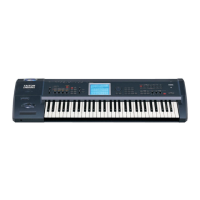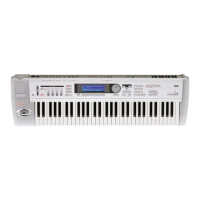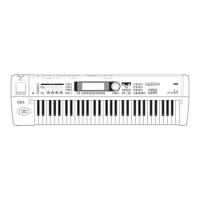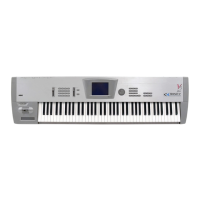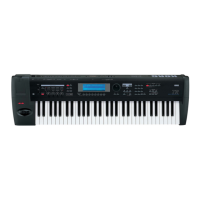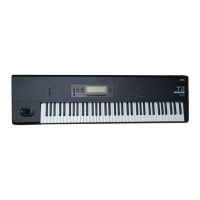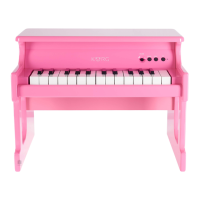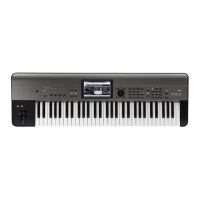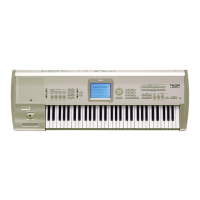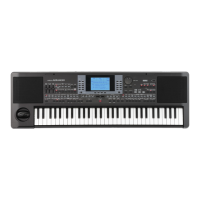iv
1. Program mode. . . . . . . . . . . . .1
Program P0: Play ......................................... 1
Select and play programs.
0–1: Perf. Edit
Select and play programs; use the
Performance Editor for simple editing
... 1
0–2: Arpeggio
Arpeggio pattern selection and settings
.3
0–3: Sampling
Perform sampling; make settings for
audio inputs etc.
......................................... 4
Program P1: Edit–Basic.................................. 7
Make basic oscillator settings and scale settings etc.
1–1: Program Basic
Oscillator settings for Single/Double/
Drums, Poly/Mono, scale etc.
.................. 7
1–2: OSC Basic
Specify the multisample for oscillators 1
and 2
............................................................ 9
1–3: Velo. Zone
Velocity zone settings
............................. 11
1–4: Controller
[SW1] and [SW2] key functions;
REALTIME CONTROLS [1]–[4] knob B-
mode functions
........................................ 12
Program P2: Edit–Pitch .................................12
Make pitch-related settings for oscillators 1 and 2.
2–1: OSC1 P.Mod
Specify oscillator 1 pitch modulation via
key position or controllers
...................... 12
2–2: OSC2 P.Mod
Specify oscillator 2 pitch modulation via
key position or controllers
...................... 14
2–3: Pitch EG
Pitch EG settings
...................................... 14
Program P3: Edit–Filter .................................16
Make filter settings for oscillators 1 and 2.
3–1: Filter1
Filter 1 (for oscillator 1) type, cutoff
frequency, and resonance settings
........ 16
3–2: Filter1 Mod.
Keyboard tracking and controller settings
to modulate the filter 1 cutoff frequency
.................................................................... 17
3–3: Filter1 LFO Mod.
Filter 1 LFO settings to modulate the filter
1 cutoff frequency
.................................... 18
3–4: Filter1 EG
Filter 1 EG settings
................................... 19
3–5: Filter2
Filter 2 (for oscillator 2) type, cutoff
frequency, and resonance settings
........ 21
3–6: Filter2 Mod.
Keyboard tracking and controller settings
to modulate the filter 2 cutoff frequency
....................................................................21
3–7: Filter2 LFO Mod.
Filter 2 LFO settings to modulate the filter
2 cutoff frequency
....................................21
3–8: Filter2 EG
Filter 2 EG settings
...................................21
Program P4: Edit–Amp.................................. 21
Make amp settings for oscillators 1 and 2.
4–1: Amp1 Level/Pan
Oscillator 1 volume and pan settings
....21
4–2: Amp1 Mod.
Keyboard tracking and controller settings
to modulate amp 1
...................................22
4–3: Amp1 EG
Amp 1 EG settings
...................................23
4–4: Amp2 Level/Pan
Oscillator 2 volume and pan settings
....24
4–5: Amp2 Mod.
Keyboard tracking and controller settings
to modulate amp 2
...................................24
4–6: Amp2 EG
Amp 2 EG settings
...................................24
Program P5: Edit–Common LFO....................... 25
Make settings for the general purpose LFOs used to cycli-
cally modulate the pitch, filter, and amp of oscillators 1
and 2.
5–1: OSC1 LFO1
OSC1 LFO1 (for oscillator 1) settings
....25
5–2: OSC1 LFO2
OSC1 LFO2 (for oscillator 1) settings
....26
5–3: OSC2 LFO1
OSC2 LFO1 (for oscillator 2) settings
....26
5–4: OSC2 LFO2
OSC2 LFO2 (for oscillator 2) settings
....26
Program P7: Edit–Arpeggiator......................... 26
Make settings for the arpeggiator.
7–1: Arpeg. Setup
Select an arpeggio pattern and make
settings
.......................................................26
7–2: Scan Zone
Specify the note and velocity ranges that
will operate the arpeggiator
...................28
Program P8: Edit–Insert Effect......................... 28
Specify the oscillator output bus, and make insert effect
settings.
8–1: Routing
Specify the oscillator output bus and set
the send levels to the master effects
......28
8–2: Insert FX
Select insert effects and turn them on/off,
and make chain settings
..........................29
8–3: IFX 1
Parameter settings for IFX1
....................30
8–4: IFX 2
Parameter settings for IFX2
....................30
8–5: IFX 3
Parameter settings for IFX3
....................30
8–6: IFX 4
Parameter settings for IFX4
....................30
8–7: IFX 5
Parameter settings for IFX5
....................30
Program P9: Edit–Master Effect ....................... 31
Make master effect and master EQ settings.
9–1: Master FX
Select master effects and turn them on/
off, and make chain settings
...................31
9–2: MFX 1
Parameter settings for MFX1
..................32
9–3: MFX 2
Parameter settings for MFX2
..................32
9–4: Master EQ
Parameter settings for master EQ
..........32
Table of Contents
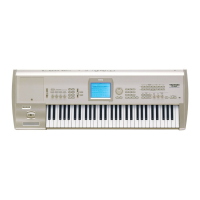
